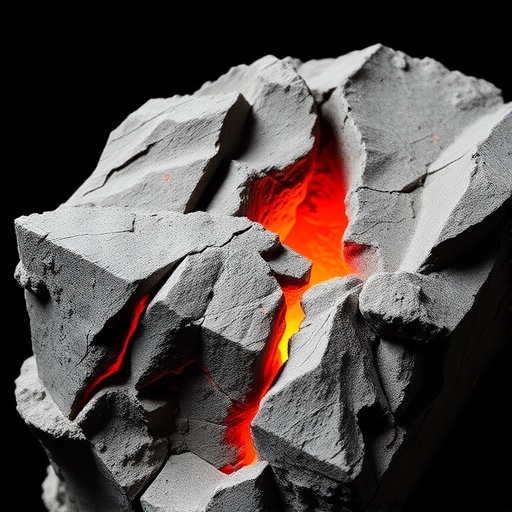In a groundbreaking study that sheds light on the intricate dynamics of subduction zones, researchers have uncovered a significant relationship between the amorphization of brucite and enhanced electrical conductivity in these geological features. Brucite, a magnesium hydroxide mineral, undergoes a transformation in certain conditions that leads to alterations in its physical properties. The implications of these changes are profound, particularly concerning our understanding of electrical anomalies often observed in shallow subduction zones. This relationship not only adds a layer of complexity to geological studies but also paves the way for potentially revolutionary applications in geophysical exploration techniques.
Subduction zones are pivotal in the tectonic behavior of our planet. They are regions where the Earth’s plates converge and one plate is forced beneath another into the mantle. These zones are characterized by intense geological activity, including earthquakes and volcanic eruptions. Understanding the processes happening within these zones can provide critical insights into the behavior of tectonic plates and the resulting geological phenomena. The study by Gui et al. emphasizes the importance of mineral transformations in this complex setting, specifically focusing on how the amorphization process of brucite influences electrical conductivity.
In deeper geological settings, brucite typically retains its crystalline form, limiting its conductivity. However, upon encountering specific conditions during subduction, brucite can amorphize—losing its ordered crystalline structure and developing a more defect-laden and potentially disordered phase. This transformation significantly impacts the mineral’s ability to conduct electricity. The researchers measured conductivity levels in brucite and found a direct correlation between the degree of amorphization and conductivity enhancement, ultimately suggesting that amorphized brucite could serve as a conduit for electrical currents in the subduction zones.
The study utilized sophisticated techniques, including impedance spectroscopy, to evaluate the electrical properties of brucite at varying temperatures and pressures. These conditions simulated those found in shallow subduction zones, thereby offering real-world applicability. The experimentations revealed that as the brucite amasses defects during amorphization, it tends to facilitate the movement of charged ions, ultimately enhancing its overall conductivity. This finding challenges previously held beliefs about brucite and draws attention to the potential of altered mineral phases in contributing to the geological phenomena observed in subduction zones.
Moreover, the researchers drew parallels between their findings and observed electrical anomalies recorded in regions of past subduction events. Such anomalies have been a long-standing puzzle for geologists, often attributed to the presence of fluids or other conductive materials. However, this new insight into brucite amorphization suggests that these anomalies may also arise from the intrinsic properties of the minerals forming at varying depths. If such a hypothesis holds true, it could fundamentally alter our interpretation of electrical signals associated with tectonic processes.
Besides its implications for understanding tectonic activities, the research presents potential applications in mineral exploration and geothermal energy assessment. As the demand for sustainable energy sources rises, understanding the electrical conductivities of various geological formations becomes vital. Enhanced conductivity indicates pathways for fluid movement, which could aid in the identification of geothermal reservoirs. As such, this research not only enriches the academic discourse surrounding geophysics but also provides tangible benefits for future energy solutions.
Another intriguing aspect of this study is its implication for the safety measures adopted in regions prone to subduction-related hazards. Understanding how brucite’s properties change could help refine the predictive tools geologists use to assess seismic risks in these volatile areas. Enhanced conductivity zones may correlate with increased seismic activity, leading to better-informed evacuation or preparedness strategies. This research underscores the interconnectedness of mineral sciences and public safety, advocating for more integrated approaches in the study of geological hazards.
As findings from this research gain traction, it is likely that they will inspire other scientists to explore the myriad ways mineral transformations can influence tectonic processes. Investigators may extend their inquiries to include how different minerals, when subjected to similar conditions, might also impact electrical properties. Such inquiries would expand the existing knowledge of mineral dynamics and provide a broader perspective on geological evolution throughout Earth’s history.
In conclusion, the work of Gui et al. represents a significant step forward in our understanding of subduction zones and the materials that compose them. By uncovering the relationship between brucite amorphization and electrical conductivity, they have opened doors to new research avenues and practical applications. The study not only enriches geological literature but also highlights the importance of integrating interdisciplinary approaches to unravel the complex interactions that define our planet.
With each discovery associated with subduction zones, the excitement grows within the scientific community. Researchers eagerly anticipate future studies that will build upon these findings, continuing to illuminate the intricate workings of our Earth’s geology. As technology improves and methodologies evolve, we can only expect more revolutionary insights into the dynamic world beneath our feet, carrying us forward in our quest to understand the Earth and its geological processes.
Subject of Research: The relationship between brucite amorphization and electrical conductivity in shallow subduction zones.
Article Title: Conductivity-elevated by brucite amorphization and implication for electrical anomalies in shallow subduction zones.
Article References: Gui, W., Liu, J., Hu, J. et al. Conductivity-elevated by brucite amorphization and implication for electrical anomalies in shallow subduction zones. Commun Earth Environ 6, 970 (2025). https://doi.org/10.1038/s43247-025-02928-4
Image Credits: AI Generated
DOI: https://doi.org/10.1038/s43247-025-02928-4
Keywords: brucite, amorphization, electrical conductivity, subduction zones, geology, mineral transformation, geophysics, seismic activity, geothermal energy.




